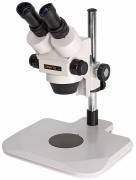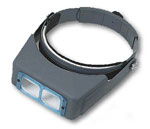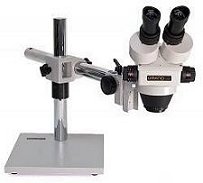Best viewed using:
Internet Explorer
or
Mozilla Firefox

Magnification and modeling...

Depending on the quality of your eyesight, the scale you model and the level of detail that you wish to achieve, being able to clearly see what you are working on has a major impact on the outcome. This may seem fairly obvious, but many modelers are not aware of magnification devices available in today’s market or their relative cost versus the benefit they provide.
Below we cover three types of magnifiers that we feel provide the greatest flexibility starting with the lease expensive.
Reading glasses (generic magnifiers) Available at just about any convenience store, prices range from $10.00 to $30.00 and magnification from 1.25X to 3.5X. Also available in the “Ben Franklin” style or half-glass which make then easy to view over at distant objects. This is a good general-purpose tool for most modeler’s workbench.
Optivisor® stereo magnifier
Manufactured by Donegan, this headband type magnifier is the absolute
standard in the industry, used by jewelers, watchmakers, and hobbyists
in general. It has a fully adjustable padded headband and ground-glass
stereo optics for excellent magnification clarity. It can be tilted out
of the way as needed and is available in 6 different magnification
strengths ranging from the Lens
Plate # 2 which magnifies 1.5 times at a distance of 20 inches to the
#10 which magnifies 3.5 times at a distance of 4 inches. Typical price
range of $33.00 to $37.00 and available at many hobby shops and at
hundreds of locations on the Internet. Reading glasses can easily be
worn with the Optivisor to further increase magnification.
Stereo Zoom Microscope
This is the granddaddy of
all magnifiers and a reasonably priced one can increase magnification
from about 4X to well over 40X (more than is practically useful). Most
modelers do not consider this as an option, but are surprised to learn
they are available for about the cost of 2 or 3 scale locomotives,
unless you model G scale (then it’s much less than 1 loco). If purchased
by a club, the cost per shared user is very inexpensive. Stereo optics
is essential for viewing object in 3 dimensions and it virtually
eliminates eyestrain associated with single-eye magnifiers. Zoom
capability allows total control for increase or decrease of
magnification as needed. As magnification increases, depth-of-field (the
area that appears acceptably sharp in the image) decreases. Therefore,
over-magnification can be adjusted out with the zoom feature. Typical
cost for a decent-but-not-laboratory-grade stereo zoom microscope starts
at about $250-$300. When working with very small components, the control
this level of magnification provides can pay for itself in a relatively
short timeframe.
As with any workbench activity using optical magnification, a good, bright, adjustable light source and comfortable chair that is height-adjustable is essential to minimize fatigue.

© 2012 Ngineering
"Being officially an old coot (turned 66 in
June 2011), I find myself using the stereo microscopes more as an alternative to the
higher power Optivisor. Having the ability to zoom in and out as needed makes those
super-detailed projects much easier to see, and much better as an end result."
In summary, each year we see the level of detail in modeling improve.
-
Advances in injection-molding and pad-printing processes have allowed manufacturers of rolling stock to greatly elevate the detailed prototypical appearance of their products.
-
The advent of laser-cutting for manufacture of wood structures have helped companies produce highly accurate products that look very realistic.
-
A Canadian company named Fast Tracks® is producing tools that greatly simplify fabrication of high-quality hand-laid turnouts and track. The results are spectacular!
-
Fox Valley Models® in Illinois is producing metal wheelsets (for both N and Z scale) that have much more prototypical appearing wheel faces and flanges.
-
The continued reduction in cost of high-quality digital photography equipment is allowing most modelers to take and share detailed images of their work.
All of these things help drive us toward improving our techniques and elevating our modeling abilities. Being able to comfortably see what we are doing is a very necessary part of honing those skills.





















